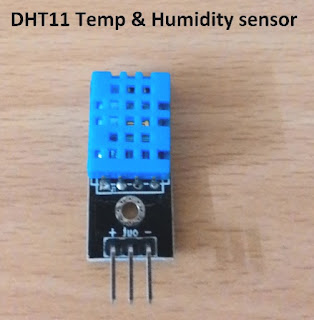In this article we are going to take a look at DHTxx series sensors, which is used for measuring temperature and humidity, both the functionality is integrated into one module.
We are going to see their specification, so that you can choose best sensor for your project and finally we are going to interface it with arduino and read the values in serial monitor of arduino IDE software.
DHTxx consist of just two series DHT11 and DHT22. The major difference between them is their specification and cost. DHT11 is low end sensor and DHT22 is high end one. DHT22 is more expensive than DHT11, but low end is decent enough for hobby project unless you do some serious measurement with you project.
DHTxx is 4-pin device one of them is NC or no connection so, we are going to use just 3-pins. Two of them are supply pins and remaining one is output pin. The sensor may look simple, but it requires a library for handling it.
The sensor consists of a thermistor, a humidity sensing device and a microcontroller embedded in a module. Their specifications are as follows:
DHT11:
• Operating voltage range is 3 to 5V.
• Its maximum current consumption is 2.5mA.
• It can measure humidity ranging from 20% to 80% -/+ 5% accuracy.
• It can measure temperature ranging from 0 to 50 degree Celsius +/- 2% accuracy.
• It refreshes it value every one second.
• Its size is 15.5mm x 12mm x 5.5mm
DHT22:
• Operating voltage is 3 to 5V
• Its maximum current consumption is 2.5mA.
• It can measure humidity ranging from 0% to 100% 2-5 % accuracy.
• It can measure temperature ranging from -40 to +125 degree Celsius +/- 0.5% accuracy.
• It refreshes it value twice every one second.
• Its size is 15.1mm x 25mm x 7.7mm
From the above raw specifications you can choose which one is optimum for your project.

The data pin always should be connected with a pull-up resistor from 4.7K to 10K. The above illustrated sensor came with PCB with eliminated NC pin and with pull-up resistor. But some sensors come without those feature, without the pull-up resistor the readings send to arduino will be fatally error values.
Now we are going to interface DHT sensor with arduino. Before proceeding the project download the library file form the following link:
https://arduino-info.wikispaces.com/file/detail/DHT-lib.zip
You just need these four components: DHTxx sensor, arduino Uno, USB cable, and a PC.
Just insert the sensor on analog pins of the arduino as illustrated in prototype and dump the code to arduino, open the serial monitor and you can see the readings.
Author’s prototype:

//----------------------Program developed by R.Girish-------------//
#include <dht.h>
dht DHT;
#define DHTxxPIN A1
int p = A0;
int n = A2;
int ack;
int f;
void setup(){
Serial.begin(9600);
pinMode(p,OUTPUT);
pinMode(n,OUTPUT);
}
void loop()
{
digitalWrite(p,1);
digitalWrite(n,0);
ack=0;
int chk = DHT.read11(DHTxxPIN);
switch (chk)
{
case DHTLIB_ERROR_CONNECT:
ack=1;
break;
}
if(ack==0)
{
f=DHT.temperature*1.8+32;
Serial.print("Temperature(°C) = ");
Serial.println(DHT.temperature);
Serial.print("Temperature(°F) = ");
Serial.print(f);
Serial.print("\n");
Serial.print("Humidity(%) = ");
Serial.println(DHT.humidity);
Serial.print("\n");
delay(500);
}
if(ack==1)
{
Serial.print("NO DATA");
Serial.print("\n\n");
delay(500);
}
}
//----------------------Program developed by R.Girish-------------//Serial monitor output:
